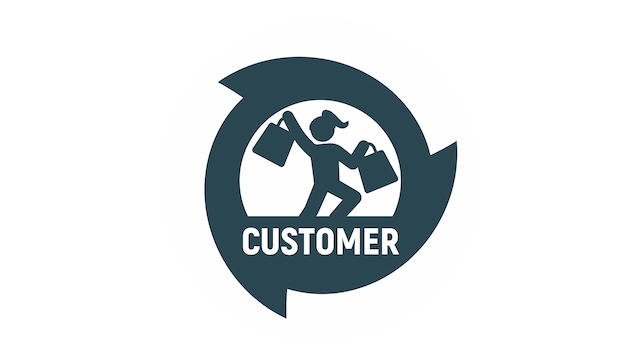Domains of Business Agility
- Customer
- / Customer
- Leadership
- / People Management
- / One Team
- / Strategic Agility
- Individuals
- / Growth Mindset
- / Craft Excellence
- / Ownership & Accountability
- Operations
- / Structural Agility
- / Process Agility
- / Enterprise Agility

Customer
01 Introduction
The heart of business agility is no less than the very reason we exist: our Customer.
“Customer” is a very broad term. Depending on the organizational context it could mean; a paying client for a private organization, a citizen for a public sector organization, or an abstraction (like “the environment” or “the community”) for an NPO (Non-Profit Organization). In some contexts, your customer may be a separate division or individuals within your organization. Although in this case, you must consider the end customer instead of delivering to a division, just because of the way the reporting lines currently work. Regardless of who your customer is, they all have one thing in common: they provide us with our purpose.
Too many organizations have forgotten that we aren't in business to make money. We are in business to serve our customer. We make a profit to continue to achieve that purpose. Think of your local doctor: most people don't become doctors to make money. They become doctors to save lives. They make money to continue saving lives.
“Profit is like the air we breathe. We need air to live, but we don’t live to breathe.”
—Frederic Laloux
Putting the Customer at the center doesn’t mean that the customer is always right or that employees or shareholders aren’t important. And, it still remains important that we make a profit! It means that almost everything that we do, within the context of your organizational values, revolves around them and informs how we make decisions. It means that the work that we do and the way that we work is for them. This is the trade-off conundrum that most organizations face.
Most companies say the customer is their top priority, but when it comes to making a decision that requires organizational leaders to choose between the customer or the company, we see many select a decision that favors the company. It is important for the leaders of every company to clearly articulate what priority they place on the customer in these decisions. This is also where the board needs to be a customer advocate as well. When the CEO makes a decision favoring the customer over the shareholders the board needs to support that decision and protect against any potential market backlash.
02 Moving from Theory to Practice
Your goal is to become a customer-centric organization, and, out of all the domains, this is the easiest to get started with.
Understand Your Customer
Detailed analytics of sales and marketing data is a good start to understanding your customer, but it’s what you do with this information that separates an agile and adaptable organization from everyone else. Using this data alongside market research, ethnographic insights, and good old-fashioned conversations with customers, you can build clear personas and empathy maps to understand who your customers are, what they think about, and how they feel. Like all models, these are generalizations but are very helpful in making strategic decisions. Finally, make sure that everyone in the organization knows who your primary customer is and who the secondary customers are.
Develop Customer Journeys
A customer journey tells the story of a customer's experience with your organization. By mapping their journey, you can identify key interactions with the customer as well as articulate the customer’s feelings and motivations for each of these interactions. When articulating the journey, it is important to document the customer’s mode of interaction, timeframes involved, and the entry and exit points of the journey.
Build Trust
If we are trying to "be" agile and leverage the natural unpredictability in the marketplace, we come up against the natural concerns and fears our customers hold. Can they trust us to act in their best interest? Can they trust us to fail fast and learn just as quickly? Can they trust us to deliver something of value? The less trust our customers have in us, the less agile we can be. This doesn’t mean we won’t fail. In fact, as a learning organization, we are certain to fail. But we have to create a culture where the lessons learned from these failures are encouraged. A culture where learning doesn't just mean learning new things but includes learning from failures. Building trust as an intentional strategy will enable us to learn more because when we inevitably fail, it is easier for our customers to forgive us.
How do you build trust? Being trustworthy is a good start - building credibility and rapport, acting with fairness & integrity, sharing knowledge, being transparent, and of course performing competently. In the book “The Trusted Advisor,” the authors offer something called “The Trust Equation” which is measured by four variables: credibility, reliability, intimacy, and self-orientation. The equation states: T = (C+ R + I) / S.
It's also worth mentioning that trust is often based on perception and public opinion, rather than reality. In an ideal world, they should be the same but acting with confidence and displaying concern or empathy are good ways of building trust at the start of a relationship.

We define this across four distinct levels.
- Reference
This is the lowest form of trust and exists where trust between the parties is based on the reference of a mutually trusted third party. - Contract
This is the most common level of trust, and the majority of relationships do not extend beyond this. This exists where parties create legally binding contracts (potentially with penalty clauses) as the core mechanism to enable trust between them. - Identification
This level of trust is created over time and exists where parties have the opportunity to work together and build trust based on personal experiences. This is where we can really start to “be” agile. - Partnership
This is the highest level of trust and exists when both parties share the same goals and outcomes. This may take the form of a strategic partnership or similar structure.
03 Measuring your Business Agility Maturity
Crawl
Walk
Run
Fly
Understand the Customer
We use detailed analytics to understand our customer's usage and requirements of our products and/or services.
We have started to use tools such as empathy maps, customer journey maps, and defined personas to understand our customer. We have objective measures of the end-to-end value which we can create for them.
We understand our customer's experiences, needs, and mission through direct engagement with them. Thus, we have developed a deep empathy which guides our business decisions to meet their expectations.
Our products and services consistently resonate with our customers and can delight them in a measurable way.
Customer as Purpose
Our strategic vision is clearly aligned to customer value, yet operational decisions tend to prioritize company profits.
We have developed a clear vision of customer value which guides decisions at all levels of the organization and creates a culture of customer orientation.
There is strong alignment between what the shareholders, executives, team members, and customers want.
Our organization structure, policies, and procedures incentivize our teams to act in the customers best interest at all times. When there is a tradeoff between what is good for the customer and what is good for the company, we prioritize the customer.

